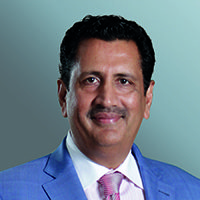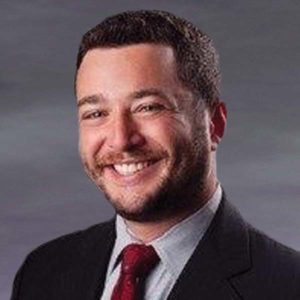 Raj Toleti comes from a family of physicians and has been around the healthcare industry his entire life. Having a front row seat has led the CEO of HealthGrid to come to a significant conclusion:
Raj Toleti comes from a family of physicians and has been around the healthcare industry his entire life. Having a front row seat has led the CEO of HealthGrid to come to a significant conclusion:
“Patients are not empowered [in the health system],” he says. “So that’s where my journey has led me. I started in the late 1990s building technology that could empower and educate patients to get a better outcome.”
Toleti, an entrepreneur at heart, had his first go-around in this arena as CEO and founder of Galvannon, which made the first commercially available patient self-service kiosk and software platforms to automate patient check-in and intake processes at hospitals. He sold that company to NCR and a few years later started another patient engagement company, which he helped run for five years.
By 2015, Toleti was at it again—starting and building up HealthGrid, which offers an enterprise mobile patient communication platform. Last year, Toleti sold HealthGrid to Allscripts for $60 million to be part of its larger health IT ecosystem. Chief Executive spoke to Toleti, who remains CEO of HealthGrid, about how the deal went down, educating providers on the benefits of investing in patient engagement and more. Below are excerpts from the conversation.
Allscripts has been very active from an M&A perspective, they’ve been able to bring together multiple [electronic medical record] systems and other technologies. Some of Allscripts’ customers…started to see FollowMyHealth (Allscripts’ patient portal product) as a best of breed patient portal, but said if you combine capabilities such as HealthGrid with FollowMyHealth, one and one can truly become more. [Allscripts CEO] Paul Black and [Allscripts’ executive] Jim Hewitt and others at Allscripts started talking to their own customer base, it was a pattern for them [to hear] that this potential combination would truly empower the customers of the patients.
So [the fall of 2017], Allscripts reached out to me… and basically we had multiple discussions, to [determine] if we felt philosophically there was a level of synergy between both organizations. And we truly felt there was a mind melt there. We’re now seeing that traction with our customer base.
Having said that, 80 percent of my customers were non-Allscripts, like Cerner, etc. At the end of the day, if you ask us what our lead is in the marketplaces, it’s that every other EMR [company] still focuses on their patient portal as their primary patient engagement capability, and we do not. So, to leapfrog that and provide engagement to 70, 80, 90 percent as opposed to patient portal engagement rates of five or 10 percent across the industry, you need something like HealthGrid. That’s what Allscripts realized and saw the synergies.
Allscripts has been one of the top three vendors for us to basically inorganically get a customer base that we can rapidly roll this out to and truly create change. Government compliance patient engagement metrics basically dwindled down to like one patient sending a secure message. I mean, we as a country have reduced the thresholds we’re shooting for. So, for us to grow the business and make an impact in the society, we truly felt that we needed to partner with one of the top vendors in the space. By partnering with Allscripts, we found a way to overcome the challenge of growing our business quickly.
What do we face from a day-to-day perspective in terms of championing this mission of empowering patients? Every time you’re in a healthcare organization, we find ourselves educating the healthcare organization on where they can begin their patient engagement journey. You can start with point of care. You can start with pre-care. You can start by automating certain things for the patient. Today the industry knows that it needs to have an effective patient engagement platform, but sometimes they’re challenged as to where they need to startbecause a number of initiatives might already be in play or multiple departments are trying to do the same thing. So, one challenge is actually creating the strategy around the patient engagement journey for healthcare organizations.
Every CEO that we talked to, patient engagement is one of their top three objectives. They have their mindshare around consumer engagement. One thing I say to CEOs is you need to have a roadmap of how to implement your patient engagement strategy. There are so many points of entry. You can do check ins, you can do gap-in-care outreach…there are multiple capabilities for a patient that you can automate. Having a clear patient engagement strategy for their own organization is going to be key. The way that they can actually get to that is to look at the current initiatives that are already in play and then put that against the backdrop of a comprehensive patient engagement strategy. If you have 20 things that you can do in this comprehensive patient engagement strategy, maybe you’re already doing five things and how do you take those five things that you’re already doing and bring to bear the best of their capabilities without any disruption? That’s really how they should be thinking about embarking upon patient engagement.
Read more: Allscripts CEO Paul Black On Navigating Healthcare’s Major Changes

Chief Executive Group exists to improve the performance of U.S. CEOs, senior executives and public-company directors, helping you grow your companies, build your communities and strengthen society. Learn more at chiefexecutivegroup.com.
0

1:00 - 5:00 pm
Over 70% of Executives Surveyed Agree: Many Strategic Planning Efforts Lack Systematic Approach Tips for Enhancing Your Strategic Planning Process
Executives expressed frustration with their current strategic planning process. Issues include:
Steve Rutan and Denise Harrison have put together an afternoon workshop that will provide the tools you need to address these concerns. They have worked with hundreds of executives to develop a systematic approach that will enable your team to make better decisions during strategic planning. Steve and Denise will walk you through exercises for prioritizing your lists and steps that will reset and reinvigorate your process. This will be a hands-on workshop that will enable you to think about your business as you use the tools that are being presented. If you are ready for a Strategic Planning tune-up, select this workshop in your registration form. The additional fee of $695 will be added to your total.

2:00 - 5:00 pm
Female leaders face the same issues all leaders do, but they often face additional challenges too. In this peer session, we will facilitate a discussion of best practices and how to overcome common barriers to help women leaders be more effective within and outside their organizations.
Limited space available.

10:30 - 5:00 pm
General’s Retreat at Hermitage Golf Course
Sponsored by UBS
General’s Retreat, built in 1986 with architect Gary Roger Baird, has been voted the “Best Golf Course in Nashville” and is a “must play” when visiting the Nashville, Tennessee area. With the beautiful setting along the Cumberland River, golfers of all capabilities will thoroughly enjoy the golf, scenery and hospitality.
The golf outing fee includes transportation to and from the hotel, greens/cart fees, use of practice facilities, and boxed lunch. The bus will leave the hotel at 10:30 am for a noon shotgun start and return to the hotel after the cocktail reception following the completion of the round.